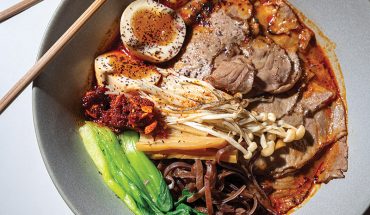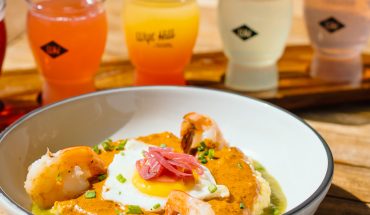
In addition to mole, another celebratory dish Salamanca favors is chile en nogada, a shredded pork mixture stuffed into poblano peppers and topped with a sauce made of walnuts, cream, and spices. “This dish was created in honor of Mexican independence,” she explains, because the green pepper, white cream sauce, and red from sometimes-added pomegranate seeds as garnish altogether suggest the country’s flag. The result of much toasting and blending and pureeing, “it is also a labor of love.”
by Jessie Ammons
photographs by Lissa Gotwals
By 10 a.m. on a weekday morning, the kitchen at Centro, the downtown Mexican restaurant, is bustling. Sous chefs are chopping pounds of tomatoes for salsa; they’re frying nuggets of hominy for bar snacks and sorting tubs of avocados. Mariachi music fills the air.
Meantime, chef and owner Angela Salamanca is closely watching a pan on her small corner stovetop – a simmering mixture of slivered almonds, aniseeds, cloves, and peppercorns is already aromatic, but it can burn quickly. This is a beginning step in the making of mole (pronounced mole-ay), a rich, traditional Mexican dish that requires attention to detail every step of the way. “Moles are super complex sauces,” Salamanca says as she heats lard in another pan and adds dried peppers. “It requires a lot of patience (already, the peppers are smoking) and ventilation! Mole is a celebratory dish because you can’t just whip it up. It’s such a process.”

Centro chef and owner Angela Salamanca.
This month, Salamanca’s mole-warranting occasion is Día de los Muertos, or Day of the Dead. Although Salamanca is Colombian, her Uncle Carlos introduced her to Mexican culture and cuisine, and she credits him as the inspiration for her eatery on Wilmington Street. Since day one the restaurant has celebrated Day of the Dead, first as a merry commemoration and now as an annual 5K charity run and brunch. Like that multilayered mole, the event has evolved, and the community around it has solidified and strengthened over time.

Each year, more than 100 kids ages 6 – 12 from the Brentwood Boys and Girls Club run the 5K race. Most of them are able to participate for free, thanks to donations from other runners. “They have a blast,” Salamanca says.
It began about eight years ago, in the early days of Centro when Salamanaca says she realized “the majority of the people that come to dine with us are not Latin American.” That market awareness is, in part, what motivated the restaurant’s first Day of the Dead celebration: A community bike ride, which made for an informal way to get Raleighites talking about the holiday and about Mexican culture.

Last year, Salamanca collaborated with Vansana and Vanvisa Nolintha of Bida Manda Laotian restaurant to prepare the family-style brunch. “My grandmother had just passed away,” Salamanca remembers, “and Van’s grandmother had passed away a few years previous. We were always having conversations about what it means to remember, where did we learn how to cook, and how to preserve these traditions.” This year’s brunch will focus on celebratory dishes.
It was such a hit that Salamanca knew she could do more by adding a charitable element. “We wanted to find a way to give back to the Latin American community, since our food had not yet found an avenue to do that,” Salamanca says. Area Boys and Girls Clubs “provide after-school programs for 90 percent of the local Latin American community. It just made sense for us to partner with them.”
Out of a desire to give back to the Boys and Girls Clubs and “do something healthy and fun and active,” the annual Day of the Dead 5K was born. Since the first race six years ago, the event has grown to include a street fiesta with vendors, food, beer, and music. “Spirited” costumes are encouraged. It all starts and ends at Centro and winds (fittingly) through historic Oakwood Cemetery. Proceeds benefit the Brentwood Boys and Girls Club on New Hope Church Road. Salamanca says it’s a meaningful way for Centro to give back to the Raleigh Latin American community, because regular customers have the chance to meet and run alongside Boys and Girls Clubs youth. Many of the kids train for and look forward to the race. “Everybody cheers each other on. There is a lot of cheering. It’s the most beautiful thing.”

At the Day of the Dead 5K race, Salamanca and friends pay tribute.
Once the cheering stops, the conversations start. “The intention of the race has always been, really, to educate people about what it means to celebrate tradition and to speak about death and be OK with it.”

A recently added mural on the patio of Gallo Pelón, Salamanca’s mezcal bar above Centro, was inspired by the logo of Espolón tequila and painted by Sean Kernick.

The Mexican flag hangs above the stairs leading up to the bar.
It’s a subject close to her heart. Because in addition to Salamanca’s general penchant for Mexican culture, her interest in Day of the Dead is personal: October marks the 13th anniversary of her sister’s untimely passing. She says the holiday’s triumphant view on the circle of life has long helped her cope. “It gave me space to celebrate my sister’s memory and mourn in a really healthy way.”
To create that for others, Salamanca turns to what she does best: a shared meal. A newly instated brunch on the morning after the 5K is served family-style and emphasizes an aspect of the Day of the Dead holiday. Last year, contributing chefs prepared recipes learned from their grandmothers. This year, the spread will include celebratory dishes, those flavors “that cause people to spend time preparing and then gather around.”

Salamanca works closely with sous chefs in the Centro kitchen.
After the plates are full, talk turns sentimental. “I love storytelling and I feel like that’s been a really good way to share with my kids about death,” Salamanca says. “I’m always looking for ways to talk to them about my sister, in a celebratory way. There’s so much power in storytelling.”

Salamanca at Centro where a wall of pots by Liz Kelly commemorates friends and supporters who contributed to her Kickstarter campaign to help fund the opening of Gallo Pelón.

A dish of mole.
Now, with years of celebrations under her belt, Salamanca feels that she’s found the right Day of the Dead balance: food and community rooted in tradition, with a festive nuance. “In this culture, death can be hard. But when people share and gather together, it’s painful and it’s intense and then it becomes healing. You take the fear out of it, because you’re facing it in a space of beauty and color.”
The sixth annual Day of the Dead 5K and street festival takes place Oct. 29 at 10 a.m.; learn more and register at dayofthedead5k.com. Admission is limited to the Oct. 30 brunch; details and tickets are available at centroraleigh.com

Mole Poblano
“This dish represents the complexity of Mexican cuisine in the many ingredients it possesses, but also shows the culture’s humility, as it can be eaten with simple rice and tortillas.”
8 mulato chiles
3 ancho chiles
3 pasillas chiles
1 dry chipotle pepper
2 tablespoons sesame seeds
2 tablespoons slivered almonds
2 tablespoons golden raisins
½ ripe plantain, fried in oil
½ cup yellow onion, diced
1 clove of garlic
1 dried clove bud
½ round tablet of Abuelita chocolate
5 black peppercorns
1 whole aniseed
1 stick Mexican cinnamon
1 small baguette
1 corn tortilla
½ cup lard
3 teaspoons salt
½ cup sugar
2 cups chile pepper water (see recipe)
1 gallon chicken stock
Devein peppers and remove seeds. In a flat pan, heat up the lard and toast the peppers; be careful not to burn them. Once all peppers are toasted, submerge in water for 30 minutes. Reserve the water for later.
In the same lard (add more if needed), toast the almonds, raisins, bread, tortilla, onion, and garlic, one by one.
In a separate pan with no lard, toast the sesame seeds and the spices.
Blend all toasted and cooked ingredients well. Add chocolate and tortilla and continue to blend. Add the water from the peppers, then add the salt, then add the sugar. In a deep pan mix the chicken stock and the blended mixture, and slow-cook for three hours.
Once you get the right consistency, it should be thick enough to coat a spoon. Add salt and sugar to taste.
Serves 10 – 12

Chile en Nogada
“This dish was created to celebrate Mexico’s independence; it represents the vibrancy of the culture not only in its colors but in its complexity of flavors.”
Filling
10-12 poblano peppers (depending on their size)
3 pounds pork shoulder
⅔ yellow onion, diced
2 garlic cloves, diced
1 teaspoon, salt
¼ cup vegetable oil
3 cups tomatoes, diced
¼ cup flat leaf parsley, chopped
½ Cripps Pink apple, chopped
1 Bosc pear, chopped
¼ cup dry apricots, chopped
¾ cup fried sweet plantains
¼ cup raisins
¼ cup slivered almonds
Pomegranate seeds, for garnish
Salsa en nogada, recipe at bottom
Cook pork with salt to taste, 1 clove garlic, ⅓ of the onion, and enough water to cover it for an hour at medium heat. Once pork is soft, cool and shred.
Roast poblano peppers over fire – you can use a gas burner flame – turning until all skin is charred. Hold in a closed bag, so that the skins will come off easily for peeling.
In a pan cook onion in oil at a medium temperature until soft. Add garlic and the rest of ingredients until the mixture thickens, about 20 minutes. Add pork and cook for 10 minutes. Adjust salt as needed.
Fill each pepper with 3-4 tablespoons of pork filling. Top with salsa en nogada and garnish with pomegranate seeds.
Serves 10-12
Salsa en Nogada
1 ½ cups whole milk
1 ½ cups heavy cream
1 cup pecans
1 cup queso fresco
1 tablespoon cherry liqueur
3 tablespoons sugar
½ teaspoon salt
Blend all ingredients for 30 seconds and refrigerate for at least 2 hours.



